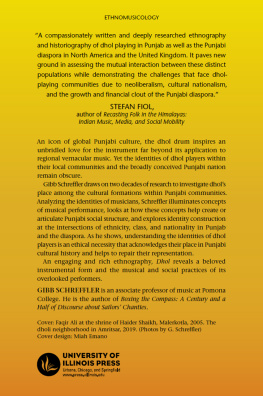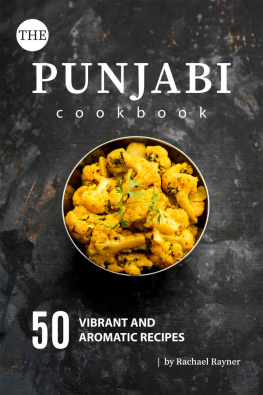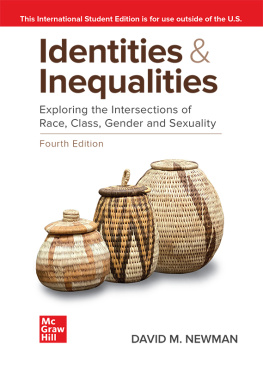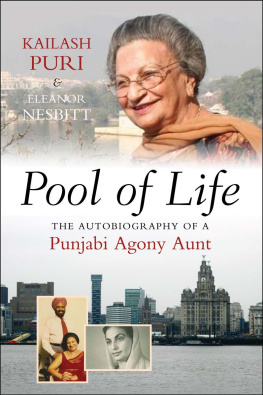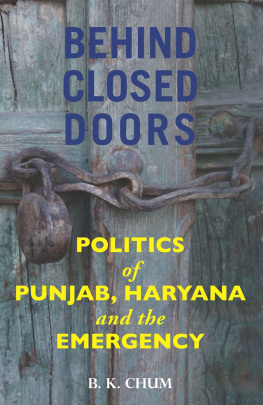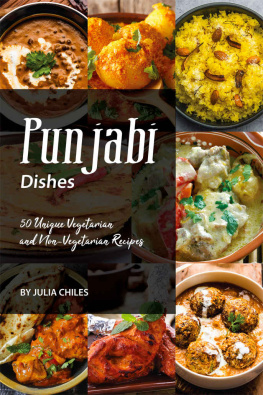Contents
Figures
Page List
Guide

The front cover of the book, DHOL Drummers, Identities, and Modern Punjab, by Gibb Schreffler. The front cover shows a man playing a two-headed barrel-shaped wooden drum with a stick. The drum is hung around his neck with a rope. The background shows a market area with similar drums on display. The title reads, Dhol: Drummers, Identities, and Modern Punjab.
dhol
dhol
drummers, identities, and modern punjab
gibb schreffler

Publication supported by a grant from Pomona College.
2021 by the Board of Trustees of the University of Illinois
All rights reserved
Library of Congress Cataloging-in-Publication Data
Names: Schreffler, Gibb, author.
Title: Dhol: drummers, identities, and modern Punjab / Gibb Schreffler.
Description: Urbana: University of Illinois Press, 2021. | Includes bibliographical references and index.
Identifiers: LCCN 2021037413 (print) | LCCN 2021037414 (ebook) | ISBN 9780252044076 (hardback) | ISBN 9780252086120 (paperback) | ISBN 9780252053016 (ebook)
Subjects: LCSH: DholiSocial aspectsIndiaPunjab. | MusicSocial aspectsIndiaPunjab. | Drummers IndiaPunjab. | Panjabis (South Asian people) MusicHistory and criticism. | Panjabis (South Asian people)Social life and customs.
Classification: LCC ML3917.I4 S35 2021 (print) | LCC ML3917.I4 (ebook) | DDC 780.954/552dc23
LC record available at https://lccn.loc.gov/2021037413
LC ebook record available at https://lccn.loc.gov/2021037414
For the dholis of PunjabMay the work go on.
CONTENTS
figures
AUDIOVISUAL EXAMPLES
Items may be found on the YouTube channel, Dhol: Drummers, Identities, and Modern Punjab, https://www.youtube.com/c/DholBook.
- 1 Excerpts from the 2004 Zonal Youth Festival, Chandigarh,
https://www.youtube.com/watch?v=5yD9T9nQeMc - 2 Annual fair in honor of Sitla Devi, village of Jarg, 2005,
https://www.youtube.com/watch?v=KCfAIb2J7gQ - 3 Calls (sadd),
https://www.youtube.com/watch?v=ZujwxoFvGcQ - 4 Wedding procession rhythm,
https://www.youtube.com/watch?v=mNGMO7-CXR0 - 5 Wedding processions,
https://www.youtube.com/watch?v=3rtqr88sECg - 6 Wheat-cutting rhythm,
https://www.youtube.com/watch?v=m2S4r2Y7n10 - 7 Hola Mahalla in Anandpur Sahib, 2005,
https://www.youtube.com/watch?v=MuTxB7cfBco - 8 Wrestling rhythms,
https://www.youtube.com/watch?v=rpvldf7OZRc - 9 Kabaddi rhythm,
https://www.youtube.com/watch?v=M39ZW4KKXi8 - 10 The shrine of Haider Shaikh in Malerkotla,
https://www.youtube.com/watch?v=NaFZnyeCamg - 11 Mother Goddess rhythm,
https://www.youtube.com/watch?v=3pI-Bss7zWA - 12 Lakhdata Pir rhythms,
https://www.youtube.com/watch?v=7JxMHjfQVjo - 13 Bhangra rhythms,
https://www.youtube.com/watch?v=AlMVJG_6tbs - 14 Tunka rhythm, https://www.youtube.com/watch?v=IO671ifyI-s
- 15 Sialkoti rhythm,
https://www.youtube.com/watch?v=Nx88Q_nqsDI - 16 Mirza rhythm, https://www.youtube.com/watch?v=Zd3hCE9nnl8
- 17 Jhummar rhythms,
https://www.youtube.com/watch?v=NzGWrTNIN3A - 18 Mens giddha,
https://www.youtube.com/watch?v=uVk3HV8Ew0U - 20 Dadra tal, https://www.youtube.com/watch?v=fIlyXymklLM
- 21 Bharai dholi Muhammad Sabi,
https://www.youtube.com/watch?v=Hl0dHb8adoc - 22 Pilgrimage to Goga Meri,
https://www.youtube.com/watch?v=sF0OLPw6kQA - 23 Ravidasia nagar kirtan,
https://www.youtube.com/watch?v=3PrFPwB1PrY - 24 Garib Dass in his own words,
https://www.youtube.com/watch?v=YozMp7tLo3A - 25 Bazi performance in Jalandhar,
https://www.youtube.com/watch?v=cH2hw9IwIao - 26 Jagat Ram dancing jhummar,
https://www.youtube.com/watch?v=vlSjPpSbpFk - 27 Children learning dhol,
https://www.youtube.com/watch?v=Y-0DghPoy4U - 28 Comparison of swing in dholi style,
https://www.youtube.com/watch?v=dgZvW2uhuGI - 29 Jago procession,
https://www.youtube.com/watch?v=2p3tHNbhAjk
note on translation and transliteration
All quotations from speech and print in languages other than English have been translated into English by the author. Non-English terms appear in native singular forms and are made plural according to English rules. Except for frequently or commonly used terms (e.g. dhol, bhangra, gurdwara, tabla), Indic words represented in Roman script are transliterated according to the International Alphabet of Sanskrit Transliteration, with a few modifications. Nasalization of long final vowels is indicated by // after the vowel. Directly before consonants, all nasal stops in the dental, palatal, and velar placement are represented by /n/. The voiceless palatal sibilant is represented by the digraph /sh/. Personal names, the names of organizations, and place names appear in the idiosyncratic Romanized spellings used by the respective parties and in local maps.
preface
hol. A beloved worda musical word, even, when spoken with the intonation of the Punjabi language. It is a beloved instrument, as well. The sight of this colorful, fat-bellied drum, provokes smiles. Its sound, deep, strong, and insistent, invites peopleirresistibly, some sayto gather and to move.
Dhol: Drummers, Identities, and Modern Punjab interrogates the gap between the unbridled love for dhol and the equivocal love for its players. It asks: who are the dhols players? Where are they positioned in relation to the cultural formations in which the instrument has an emblematic place? In combination: what are the identities of Punjabs dhol players, situated with respect to both their positions in local communities and a broadly conceived Punjabi nation?
Inquiry into the identities of dhol players is driven by documentary, intellectual, and ethical interests. This book documents rich ethnographic data about diverse ethnic communities of Punjabi origin whose continued social and discursive marginalization has rendered them less visible. Because they are most visible in musical contexts, musicological study brings these communities and their cultural formations to the fore. Intellectually speaking, analysis of the identities of dhol players yields insight into Punjab-based concepts of musical performance and how these concepts work to create or articulate social structure. Modern Punjab, as a case study, contributes to thought about identity construction at the intersections of ethnicity, class, and nationality, both locally realized and extrapolated internationally. Addressing current ethical concerns, this work engages debates on cultural appropriation by illustrating how questions about ownership of cultural practices are complicated by competing existential and ideological struggles over identity. It asserts that to reveal the identities of dhol playersas they have been, typically and historicallyis an ethical necessity that acknowledges their place in Punjabi cultural history and helps to repair their representation.
This work is the fruit of two decades of research and critical observation. The bulk of data derives from fieldwork on the participant-observation model. I made extended trips to India in 2000, 2001, 20042005, 2006, and 2019, and short trips to Pakistan in 2001 and 2006. The extremities of my research area in South Asia were the edge of Balochistan in the West, central Uttar Pradesh in the East, Jammu in the North, and Delhi in the South. In 2009, 2018, 2019, and 2020, I worked with dhol players of diaspora communities in London (U.K.), California, New York, Ontario, and British Columbia. In the gap years of 2003 and 2007, I brought my primary mentor, Ustad Garib Dass, to my home for several weeks. Over the years, I also engaged sporadically with artists in North America in-person and via distance communication.

